Mulching with cardboard is a fantastic way to start a no-dig garden. Cardboard will smother weeds, keep moisture in the soil and is an easy way to make garden paths. Cardboard can be used as a base under mulch to improve your soil and encourage worm and microbe growth. It is great for vegetable gardens, established trees and flower beds.
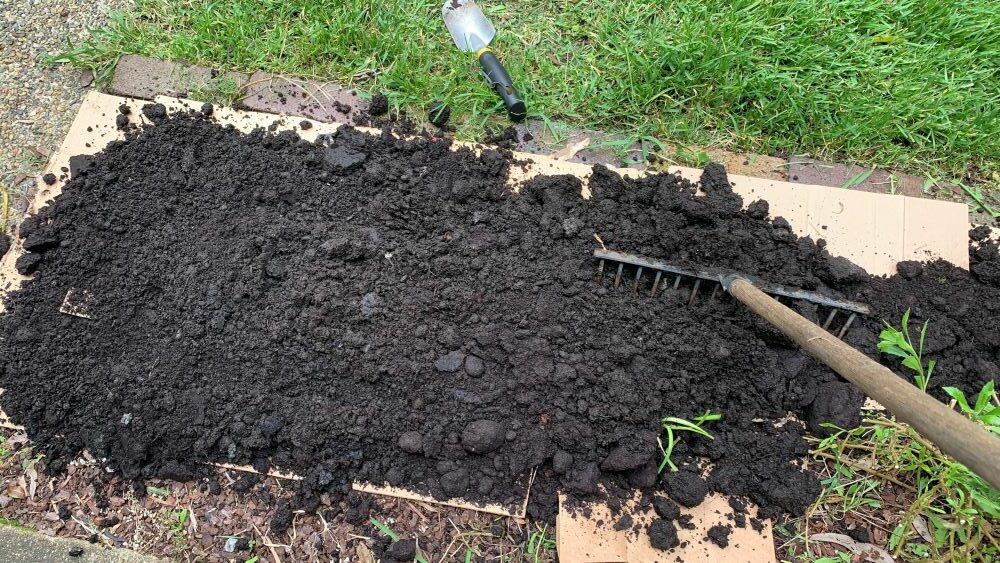
Cardboard as will will help to retain moisture, keep weeds down and improve soil health. While there are many types of mulch available, cardboard mulching is great because it is cheap, lasts for months and reduces waste.
Cardboard mulching involves using flattened cardboard boxes as a layer of mulch over the soil. This technique helps to suppress weeds by blocking sunlight and can also improve soil health by adding organic matter as the cardboard breaks down. Cardboard mulching is an eco-friendly option as it repurposes waste materials that would otherwise end up in landfill.
Whether you’re a seasoned gardener or just starting, this guide will provide you with all the information you need to get started with cardboard mulching.
Key Takeaways
- Cardboard mulching is an eco-friendly and effective way to suppress weeds and improve soil health.
- To get started with cardboard mulching, you’ll need flattened cardboard boxes, a source of water, and a layer of organic mulch.
- Avoid common mistakes such as using glossy or colored cardboard and not wetting the cardboard thoroughly before applying.
Why mulch with cardboard?
Mulching with cardboard is a gardening technique that involves using cardboard as a layer of mulch to cover the soil. It is an eco-friendly and cost-effective way to suppress weeds, retain moisture, and improve soil health.
You can use recycled cardboard boxes that are flattened and placed on top of the soil. The cardboard should be free of tape, staples, and any other non-biodegradable materials. It is important to note that glossy or colored cardboard should not be used for mulching, as it may contain harmful chemicals that can harm plants and soil. It is a natural way to prevent weed growth instead of using inorganic methods like landscape fabric.
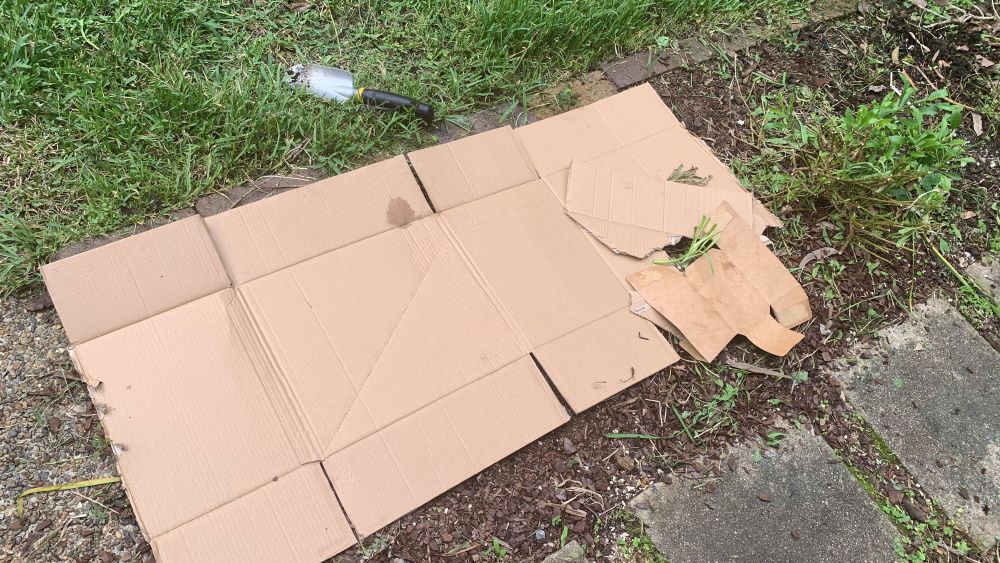
Cardboard mulch is an excellent way to create a no-dig garden bed. By layering cardboard with other organic materials such as compost, straw, or leaf mold, you can create a nutrient-rich environment for your plants. The cardboard acts as a barrier to prevent weeds from growing while also retaining moisture in the soil.
Using cardboard mulch can also help to improve soil health by encouraging the growth of beneficial microorganisms and earthworms. As the cardboard breaks down, it releases nutrients into the soil, which can benefit your plants.
Benefits of Mulching with Cardboard?
Cardboard mulching is a great way to improve your garden’s soil, control weeds, and conserve water. Here are some of the benefits of using cardboard as mulch:
Soil Improvement
Cardboard is a natural source of carbon, which is essential for soil health. When you use cardboard as mulch, it breaks down slowly over time, releasing carbon into the soil and improving its structure. This helps to create a healthy environment for beneficial microorganisms and earthworms, which in turn help to break down organic matter and make nutrients available to your plants.
Cardboard mulch also helps to retain moisture in the soil, reducing the need for frequent watering. As the cardboard breaks down, it adds organic matter to the soil, further enhancing its fertility.
Weed Control
One of the biggest benefits of cardboard mulching is its ability to control weeds. When you lay cardboard down on top of your soil, it blocks sunlight from reaching weed seeds, preventing them from germinating. This means less weeding for you, and a healthier garden overall.
Cardboard mulch can also help to smother existing weeds, preventing them from taking over your garden. Over time, the cardboard breaks down and becomes part of the soil, further reducing the likelihood of weed growth.
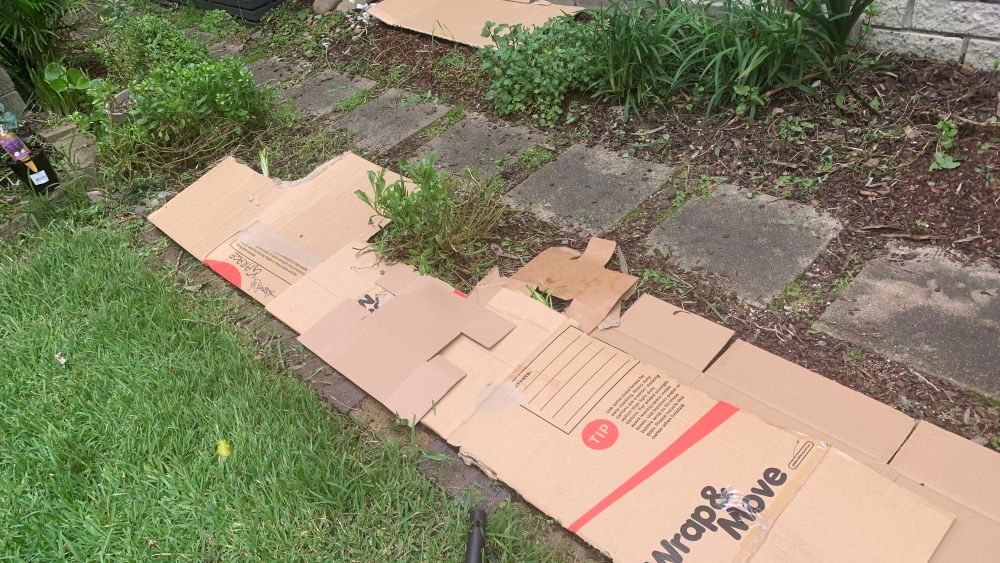
Saves Water
Cardboard mulch can help you to save water in your garden. By blocking sunlight and retaining moisture in the soil, cardboard mulch reduces the amount of water that evaporates from the soil surface. This means you can water less frequently, saving time and money.
In addition, cardboard mulch helps to prevent soil erosion, which can be a problem in areas with heavy rainfall or steep slopes. By holding soil in place, cardboard mulch helps to protect your plants and keep your garden healthy.
Materials Needed for Cardboard Mulching
To get started with cardboard mulching, you will need a few materials to ensure success. Here are the essential materials you will need:
Corrugated Cardboard
Corrugated cardboard is the best type of cardboard to use for mulching. It is sturdy and allows for air circulation, which is essential for the soil to breathe. You can easily find corrugated cardboard at your local grocery store or online. Flatten the box into a large piece. You then cut it into smaller pieces to fit your space with garden scissors. If you find thick cardboard, then you will only need one layer to use it as mulch.
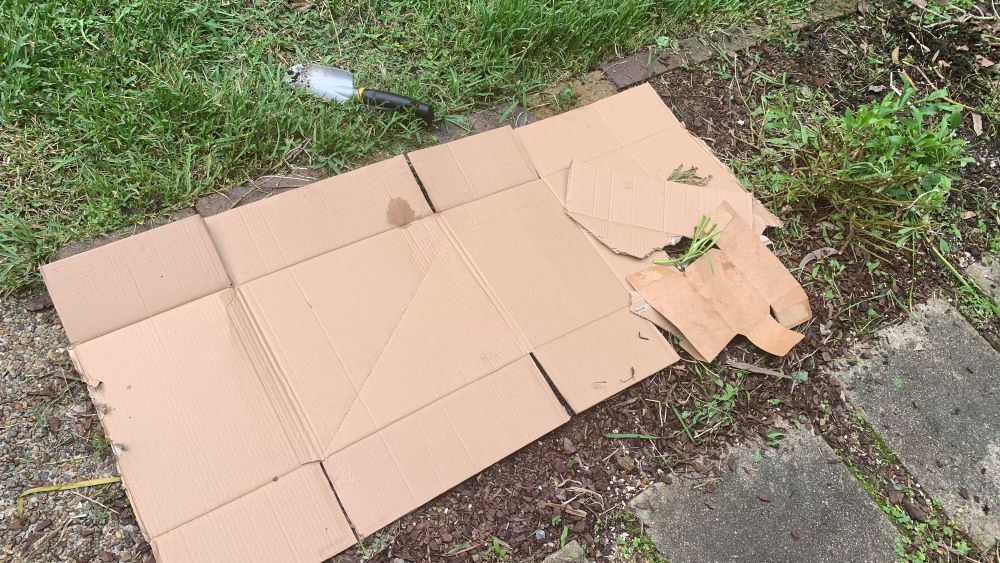
Mulch
Mulch is essential to cover the cardboard and provide additional benefits to your garden. You can use any type of mulch, such as wood chips, leaves, or straw. Mulch helps retain moisture, suppress weeds, and regulate soil temperature.
Compost
Compost is an excellent addition to cardboard mulching. It adds nutrients to the soil and helps break down the cardboard quicker. You can make your own compost or purchase it from a local garden center.
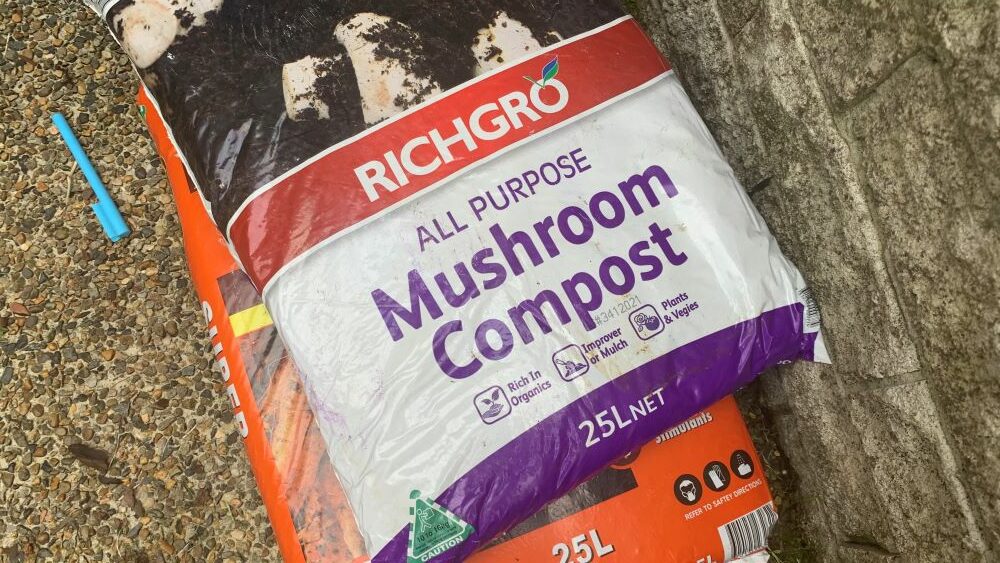
Garden Scissors
Pruners are necessary to trim any excess cardboard and ensure it fits snugly around your plants.
Step-by-Step Guide to Cardboard Mulching
Mulching with cardboard is an excellent way to suppress weeds, improve soil health, and create a nutrient-rich environment for plants to grow. Here are the simple steps to mulch with cardboard.
Collect your Cardboard
Collect cardboard boxes of different sizes. Remove any tape or labels, if possible, but don’t worry if there are small pieces left over. These will decompose over time.
Cut the cardboard into manageable pieces, about 2-3 feet in size. This will make it easier to handle and spread over the garden.
Lay out your cardboard
- Remove the weeds in the area where you want to apply the cardboard. This will help the cardboard lay flat on the ground.
- Lay the cardboard over the area without leaving any gaps. Overlap the edges of the cardboard by a few inches to ensure complete coverage.
- Wet the cardboard with a hose or sprinkler. This will help the cardboard break down faster and prevent it from blowing away.
- You can then cover the cardboard with compost if you choose. This will help the cardboard to break down and feed the soil.
- Cover the cardboard with a 2-3 inches of mulch. You can use compost, straw, pine needles, shredded paper, grass clippings or wood chips. You can also use inorganic mulch such as rocks or pebbles for gardens with succulents or cacti.
- Water the area again to settle the layers into place.
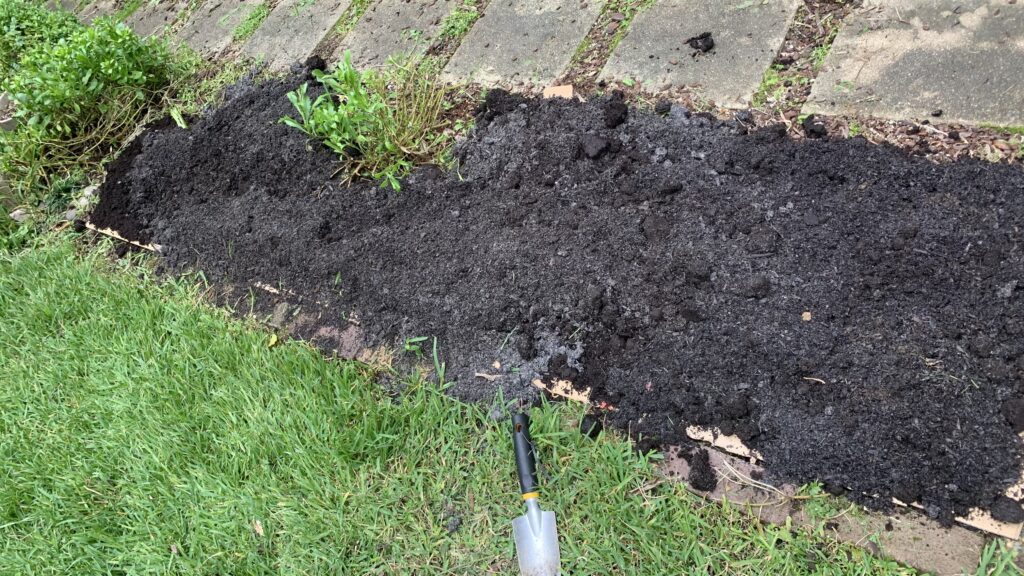
Maintain your Cardboard
- Water the area regularly to keep the cardboard moist. This will help it break down faster and provide nutrients to the soil.
- Check the area periodically for any gaps in the cardboard. If you find any, simply add more cardboard and cover it with compost, straw, or wood chips.
- After a few months, the cardboard will begin to break down and turn into rich, fertile soil. At this point, you can plant your desired plants directly into the mulch.
How to use cardboard to make a no-dig garden bed
To make a no-dig garden bed using cardboard:
- Clear the area of weeds and debris to make room for the new bed.
- Cover the area with a layer of cardboard.
- Water the cardboard in to settle it into place.
- Cover the cardboard with a 2-3 inch layer of compost.
- Cover the compost with a 1 inch layer of straw.
- Repeat 2-3 times.
- Allow the garden bed to break down for 3-6 months.
- Plant into the area when the garden bed resembles soil.
Note: if you want to plant directly into the garden bed, add good quality potting or raised garden mix in the areas you want to plant.
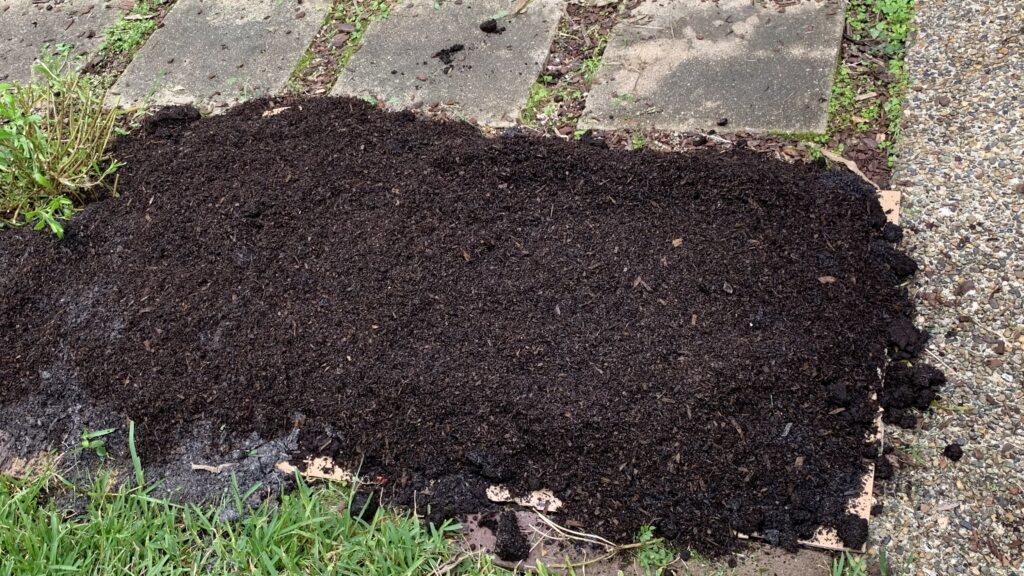
How to use cardboard to create paths
Using cardboard as a base to create a natural, movable path is a fantastic idea. If you have an area between vegetable garden beds or down the side of your house that you would like to turn into a path then using cardboard is a fantastic way to do this.
- Pick the area that you want to lay the path and rake the area flat.
- Remove any weeds in the area.
- Cut the cardboard into the shape of the path and lay it down where you will want to walk.
- Lay bark chips over the top to hold the cardboard in place.
This simple method of making a path using cardboard is a great way to stop weeds from growing through. The cardboard will stop the weeds from getting light and growing through your bark chips. Make sure that you don’t leave any gaps when laying your cardboard and it will work well.
Common Mistakes to Avoid when Mulching with Cardboard
When it comes to mulching with cardboard, there are a few common mistakes that beginners tend to make. Here are some things to keep in mind to avoid those mistakes:
Using Coated or Colored Cardboard
One of the most common mistakes is using coated or colored cardboard. This type of cardboard can take a long time to break down. It’s best to use plain cardboard that doesn’t have any coatings or colors.
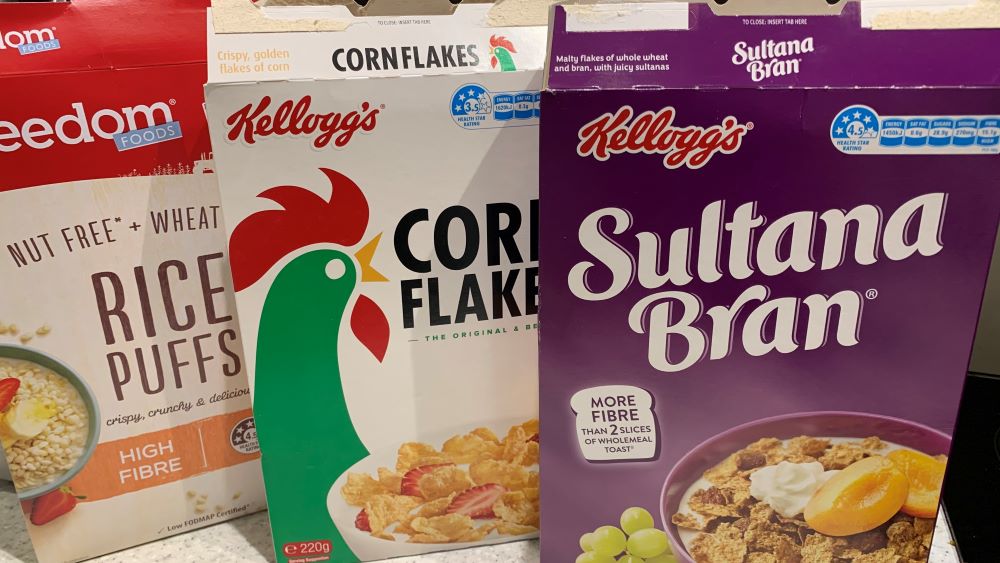
Not Preparing the Area
Another mistake is not preparing the area before laying down the cardboard. Make sure to remove any weeds or grass from the area and level the ground. This will help the cardboard lay flat and will help to keep the area weed free for longer.
Using Too Little or Too Much Cardboard
Using too little cardboard can result in weeds growing through the mulch. On the other hand, using too much cardboard can prevent water and nutrients from reaching the soil. A good rule of thumb is to create a single, solid layer of cardboard without gaps. Overlap the edges to stop sunlight from getting through to the soil.
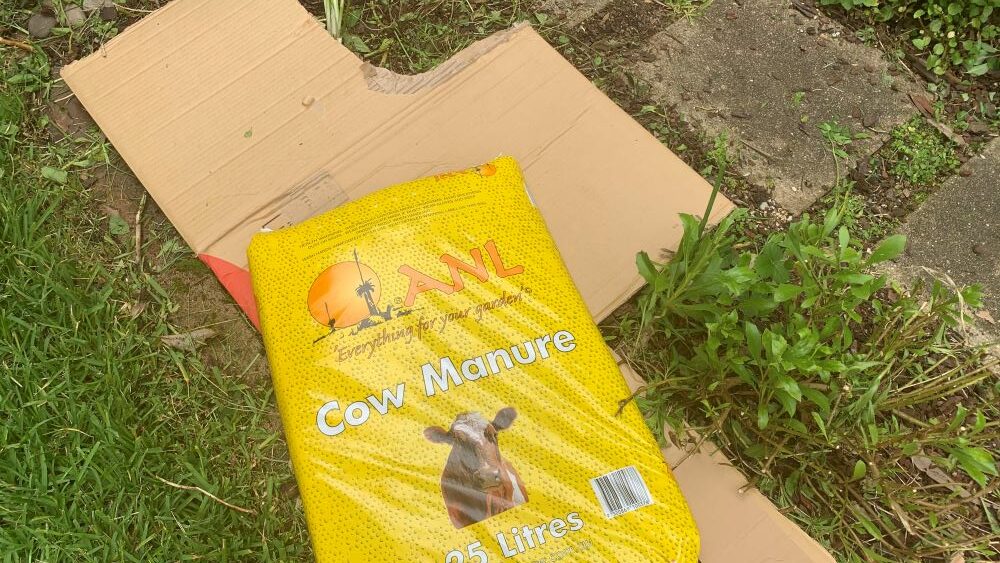
Not Watering the Cardboard
Watering the cardboard is important to help it break down and decompose. Without water, the cardboard can take longer to decompose and can prevent water from reaching the soil. Make sure to water the cardboard after laying it down and regularly after that.
Using Cardboard with Tape or Glue
Using cardboard with tape or glue can prevent it from breaking down properly and can harm your plants and soil. Make sure to remove any tape or glue from the cardboard before using it as mulch.
Alternatives to Cardboard Mulching
While cardboard is an effective and eco-friendly mulching material, there are other options available for those who prefer different materials or have difficulty sourcing cardboard. Here are some alternatives to cardboard mulching:
Newspaper
Newspaper is a readily available and affordable option for mulching. It is biodegradable and can be layered similarly to cardboard. Simple layer 3-6 sheets of newspaper over a preprepared bed. Newspaper however may not as effective as cardboard in suppressing weeds and may require more layers to achieve the same results.

Straw
Straw is a popular mulching material that is readily available at garden centers and farms. It works well to stop weeds and retains moisture well.
Wood Chips
Wood chips are a long-lasting and effective mulching material. They are readily available at garden centers and tree trimming services. Wood chips work well as a mulch on their own or applied as a top layer on your cardboard.
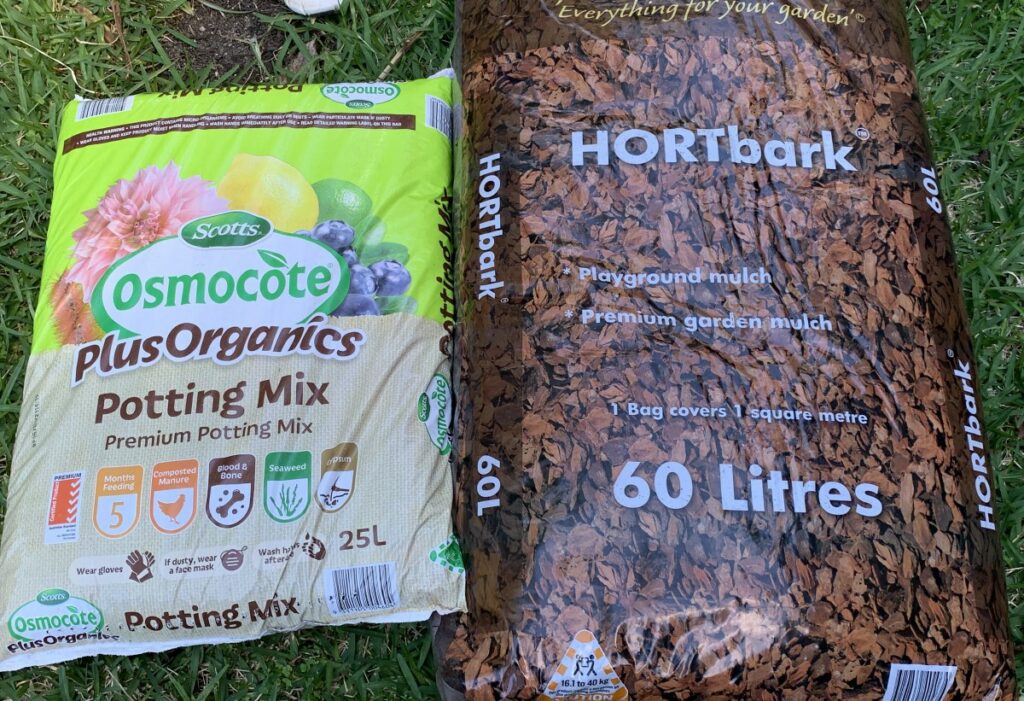
Mulching with Cardboard – Pros and Cons
Check out the pros and cons of mulching with cardboard.
Pros
Cardboard smothers weeds
Cardboard is fantastic for smothering weeds and forms the first layer of the no till garden method. When using this method, layers of cardboard are placed over weeds which will stop them from getting light and they will eventually die off under the cardboard. This is particularly good for soft weeds that do not have runners like clover and chickweed.
Layer the cardboard without leaving any gaps and place it straight over the weeds. Layer compost, straw or wood chips over the top of the cardboard to hold it in place and stop it from drying out. The cardboard will break down over time killing off the weeds. This will create fantastic soil to grow fruit trees, vegetables or flowers.
To start a no dig garden, check out this great video below that uses cardboard as a mulch.
Cardboard adds organic matter to improve your soil
Cardboard is a high carbon material and contains air pockets between the layers. This allows microbes to come in and start breaking down the cardboard into your soil. Worms will be attracted to both the cardboard and the bacteria and will continue the breakdown process.
Check out this video for a quick guide to using cardboard in your garden as mulch.https://www.youtube.com/watch?v=HIWDPlaB6wY&t=43s
Laying cardboard down as a mulch will help to keep moisture in the soil creating the perfect environment for microbes and worms to thrive.
Cons
Cardboard can be plastic coated
Some cardboard contains a plastic coating and colored ink which will get into your soil and take a long time to break down. Adding this to your garden can cause moisture build up and you could be adding chemicals into your garden that you don’t want. Choose plain cardboard to use as mulch in your garden instead.

Cardboard can be covered in tape
Depending on the box structure some cardboard can be closed with plastic tape. This is common for moving boxes where they have been closed at home using packing tape. You should remove the tape from the cardboard before putting it in your garden. The tape will take a long time to break down and can end up in your soil.
Cardboard can attract bugs
Anytime you lay something flat on the soil surface it becomes a hiding place for insects and creatures. You may find that slugs, snails, spiders, lizards and ants can all enjoy living underneath your cardboard. While this is not a problem, be very careful if you live in an area with snakes as they may make a home under the cardboard as well.
To be as safe as possible, do not lift the cardboard with your hands, particularly in warm weather. You should not need to lift your cardboard at all as once it is laid you should put wood chips or straw over the top to hold it down.
Best cardboard to use as mulch
Cardboard comes in many thicknesses, coatings and colors and some are great for using in the garden. To mulch safely with cardboard choose a cardboard that is plain and does not contain large amounts of ink. Some cardboard can contain a plastic coating or adhesive and will take much longer to break down. Egg cartons and plain brown cardboard make great mulch in your garden.
- Plain cartons or shipping boxes like Amazon boxes. Look out for cartons that have minimal or no ink.
- Plain shoe boxes
- Egg cartons are a fantastic cardboard for your garden as they are a soft cardboard and will break down quickly.
Cardboard to avoid using for mulch
Most will be Tissue boxes and cookie boxes also come with a plastic coating so are not a great choice for your garden.
Egg cartons made with plain cardboard can be a great mulch or added to your worm farm
How long cardboard takes to break down in a garden
Cardboard can take anywhere from 3-6 months to break down in your garden. This will vary depending on how thick the cardboard is and the conditions. In warm moist conditions cardboard will be broken down in around 3 months if laid under bark chips or compost. Microbes and worms will break down the cardboard and mix it in with the soil.
Using shredded cardboard as mulch
Shredded cardboard can be a good mulch if mixed with wood chips or compost. Shredded cardboard on its own will become too dry and can blow away. Mix it together with other mulch types to hold it in place and water it in well.
Summary
Cardboard is a low cost or completely free way to stop weeds and mulch your garden. When used in combination with bark chips it can make a fantastic path or no dig garden. Keep moisture in your soil and support microbe growth by laying cardboard as a mulch.
By using cardboard as a weed barrier, you can reduce the need for herbicides and save time and money on weeding. Cardboard adds organic matter to the soil as it breaks down, improving its structure and fertility.
When using cardboard as mulch, it is important to follow some best practices. Make sure to use plain cardboard without any tape or plastic, and overlap the pieces to prevent weeds from growing through gaps. Wet the cardboard thoroughly after laying it down, and add a layer of compost or other organic material on top to encourage decomposition.
While cardboard mulch is effective, it may not be suitable for all situations. Cardboard mulch may not be the best choice for plants that require a lot of water, as it can prevent moisture from reaching the soil.
Overall, mulching with cardboard is a great option for gardeners looking to reduce their environmental impact and improve soil health.
Frequently Asked Questions
How do you prepare cardboard for mulching?
To prepare cardboard for mulching, remove any tape or labels from the cardboard and cut it into pieces. Wet the cardboard with a hose to help it decompose faster and lay it down flat on the soil. You can also shred the cardboard for faster decomposition.
What are the benefits of using cardboard as mulch?
Using cardboard as mulch has several benefits. It suppresses weeds by blocking sunlight, retains moisture in the soil, and improves soil health by adding organic matter. Cardboard also breaks down slowly, providing long-term benefits to your garden.
Can you use cardboard under mulch around trees?
Yes, you can use cardboard under mulch around trees. It will help suppress weeds and retain moisture in the soil. However, make sure not to cover the trunk of the tree with cardboard or mulch, as it can cause the tree to rot.
Where can you find free cardboard for gardening?
You can find free cardboard for gardening at local stores or businesses that receive shipments. Ask for their cardboard boxes or check their recycling area. You can also ask friends or neighbors for their cardboard boxes.
Will roots grow through cardboard used for mulching?
New plants grown on top of cardboard mulch will usually not be able to push their roots through the cardboard. If you want to plant in an area that you have laid cardboard mulch, make a small hole in the cardboard and plant straight into the soil below.
How many layers of cardboard are needed for effective mulching?
The number of layers of cardboard needed for effective mulching depends on the thickness of the cardboard and the type of plants you are growing. Generally, one to two layers of cardboard is enough for to stop weeds and improving soil health.
Len laying your cardboard and it will work well.
Check out this video for more on making paths with cardboard and wood chips in your vegetable garden.
I am an accredited practicing dietitian, experienced gardener and a dedicated cook. I love writing and sharing my experience so you can learn from my successes and mistakes.
